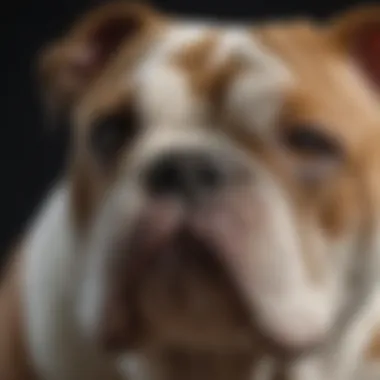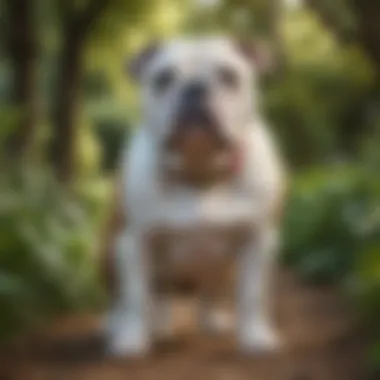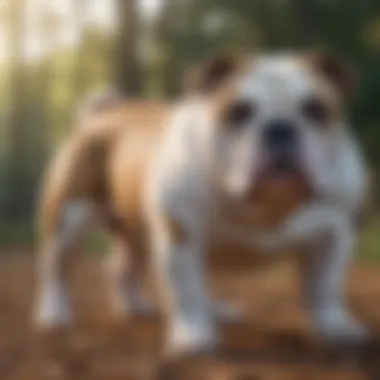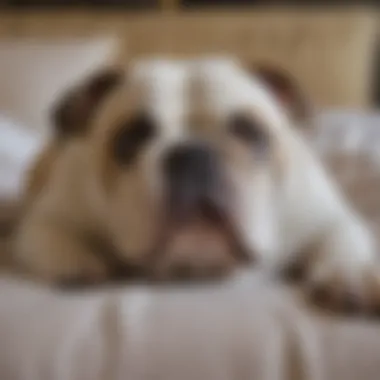Understanding the Old English Bulldog Breed


Intro
The Old English Bulldog is a breed that draws the attention and curiosity of dog lovers around the globe. With a history that echoes through centuries, this breed wasn't just bred for looks; it has been shaped by its roles and the environment in which it lived. Its unique characteristics and temperament tell a story of resilience and adaptability.
Originating in England, this breed carries a sense of pride, steeped in tales of valor and loyalty. From the rugged terrains of its homeland to the cozy living rooms of modern families, the Old English Bulldog has walked many paths. Understanding this breed requires delving into its past, Physical traits, and how it interacts socially—both with humans and other dogs. Through this exploration, enthusiasts and potential owners can appreciate the nuances that come with caring for an Old English Bulldog.
This guide will cover a wealth of information. From key historical milestones to the intricacies of their behavior and health considerations, we aim to provide an insightful resource. The path of owning an Old English Bulldog is lined with challenges and rewards; knowing these aspects is essential for making informed decisions. Let's embark on this journey, unlocking the fascinating world of the Old English Bulldog.
Historical Background of the Old English Bulldog
The Old English Bulldog possesses a rich tapestry of history, making its historical background crucial for understanding the breed today. Knowledge of its origins and development helps enthusiasts and potential owners appreciate its unique characteristics and traits. This section covers key aspects that shape the breed's identity, and sheds light on how it has evolved to be what it is now. The Old English Bulldog is more than just a dog; it embodies stories of cultures, purposes, and human interactions.
Origins and Ancestry
The roots of the Old English Bulldog trace back several centuries, with various influences contributing to its lineage. Initially, this breed was developed primarily in England for specific tasks, including bull-baiting—a cruel sport that, while now outlawed, speaks volumes of the breed’s strength and tenacity. It’s believed that ancient dogs, akin to today’s Mastiffs and bulldogs, were bred together to create a powerful and agile canine capable of enduring harsh conditions.
One can look into the annals of the 17th century to trace the breed’s ancestry more precisely. During this time, bulldogs were vital to farmers, serving a role in herding and managing livestock. Despite this practical purpose, the breed’s popularity surged mainly due to its strength and endurance—traits that allowed it to survive in a demanding environment.
Evolution of the Breed
As the societal landscape shifted, so too did the perception and the function of the Old English Bulldog. From its earlier days of working with livestock, the breed started to transition into a companion animal. In the late 1800s, when animal rights movements began to take shape, the cruel traditions surrounding bull-baiting became a thing of the past.
The breeding practices began to change as well. Selective breeding focused on temperament and appearance, shifting the emphasis towards the dog’s demeanor while maintaining its sturdy build. By the mid-20th century, the breed was finding its place as a beloved family companion. No longer simply associated with labor and sport, the Old English Bulldog emerged as a symbol of resilience and loyalty. This ongoing evolution continues to affect how the breed is viewed and cared for.
Cultural Significance
The Old English Bulldog occupies a notable place in cultural expressions, ranging from literature to art. Its image has often been used to symbolize fortitude and determination. For instance, in the realm of British culture, it can often be seen as the embodiment of the stoic British spirit. Songs and poems have celebrated its steadfast nature, while visual arts frequently feature the breed as a subject of admiration.
Moreover, the Bulldog is recognized as a national emblem in England, often appearing in political cartoons as a representation of British fierceness. This diverse cultural significance not only enhances its value as a pet but also deepens its connection to human experiences over generations.
"To understand a breed fully, one must appreciate its historical journey, not just the physical features it exhibits today."
In summary, the historical background of the Old English Bulldog is paramount in comprehending its presence in today’s society. Understanding its origins, evolution, and cultural significance is essential for anyone looking to adopt or work with this breed.
Physical Characteristics
The physical traits of the Old English Bulldog play a crucial role in defining its uniqueness and appeal. Each characteristic not only influences the animal's appearance but also impacts its behavior, health, and even the kind of care it requires. Understanding these elements helps potential owners make informed decisions and fosters appreciation among enthusiasts. In this section, we’ll delve into the size and build, coat, and distinctive facial features that make this breed so noteworthy.
Size and Build
When it comes to size, the Old English Bulldog is not just compact; it’s powerful. Adults typically weigh between 60 to 130 pounds, with males being generally larger than females. Their solid, muscular stature gives them a stocky appearance, akin to a robust athlete.
This build serves various purposes. Their strong body allows for physical endurance, which is essential given their historical role as working dogs. On top of that, their broad shoulders and deep chest create an impressive presence, often making them seem more imposing than they really are. However, one must also consider that their size means they require ample space to roam and play. Having a backyard isn’t just a luxury, it’s a necessity.
Coat and Color Varieties
Coat is another significant feature, providing not only aesthetic beauty but also serving practical purposes. The Old English Bulldog sports a short, fine coat that feels smooth to the touch. This coat comes in a variety of colors including brindle, white, fawn, and combinations of these. Each hue can reflect different traits and familial backgrounds.


Moreover, the coat type is vital for owners to understand when it comes to grooming. Because the hair is short, maintaining cleanliness is relatively easy – yet, shedding can still be an issue. Regular brushing helps in minimizing loose hairs around the house, and also fosters a bond through the grooming process. It’s amazing how much one-on-one time you can spend just ensuring your dog looks its best.
Distinctive Facial Features
The face of the Old English Bulldog is arguably its most captivating characteristic. With its broad head and defined cheek muscles, many find its visage to be quite endearing. They have a short, flat muzzle with a pronounced underbite, adding an air of stubbornness that many owners find charming. Their eyes, typically dark and expressive, can reflect a range of emotions from mischief to affection.
Furthermore, these facial features are more than just for show; they can indicate health issues. The structure of the face can result in breathing problems, particularly in warmer climates or during strenuous activities. It’s essential for owners to monitor their breathing patterns and be mindful of overexertion. As such, knowledge of these elements can greatly enhance an owner’s capability to provide care.
In summary, the Old English Bulldog's physical characteristics are not just for aesthetics; they serve functions that require consideration for health, care, and lifestyle compatibility. Being well-informed about these traits allows for a more rewarding companionship and happier pets.
Temperament and Behavior
Understanding the temperament and behavior of the Old English Bulldog is crucial not just for potential owners, but also for veterinarians and wildlife biologists studying canine behavior. These dogs are known for their unique personality traits that embody a mix of strength and gentleness. Exploring these traits will provide insight into the breed's compatibility with different lifestyles, making it essential for anyone considering bringing an Old English Bulldog into their home.
General Personality Traits
The Old English Bulldog often carries a stoic demeanor but has a surprisingly affectionate side. They tend to be loyal to their families, often forming strong bonds with children. Their general disposition is calm and courageous. Here’s a deeper look into some highlight traits:
- Loyal Companion: Their fierce loyalty makes them protective, which can be comforting for families.
- Gentle Giant: Despite their muscular build, they really are gentle with family members and often enjoy being cuddled.
- Reserved: These dogs may not be overly boisterous or demanding. They tend to have a mellow temperament, which can ease the atmosphere in a household.
Due to their relatively calm nature, these traits make the Old English Bulldog an excellent choice for residential living, particularly for families seeking a level-headed pet.
Social Interaction
Socialization is important for the Old English Bulldog and can impact their interactions both with other pets and humans. Early socialization enhances their comfort levels with different environments, people, and animals, ensuring they grow to be well-adjusted adults. Here’s why social interaction is key:
- Family Integration: These dogs often enjoy the company of their human families, and they can form strong bonds that lead to loyalty.
- Other Pets: While they have a sturdy build, they can often coexist peacefully with other pets, given early exposure.
- Sensory Awareness: Their alertness makes them respond well to social cues. Understanding body language in both dogs and humans allows them to navigate social situations more effectively.
Notably, failure to socialize can lead to wary tendencies towards strangers or unfamiliar animals, so it’s essential for their well-being.
Training and Obedience
Training an Old English Bulldog requires patience and a fair hand. Their friendly nature is complemented by a decent intelligence, but they can sometimes exhibit stubborn traits. The training method makes a tangible difference in the outcome, so here are several considerations:
- Positive Reinforcement: Utilizing treats and praise helps motivate them, as they thrive on feedback and affection.
- Short Sessions: They tend to maintain focus better during brief, consistent training sessions rather than long, drawn-out ones.
- Social Learning: Incorporating other dogs into training can enhance learning outcomes and encourage social behavior.
"Proper training can transform a spirited pup into a well-mannered companion."
Their eagerness to please, paired with the right techniques, can yield excellent results, turning training sessions into delightful bonding experiences.
In summary, the temperament and behavior of the Old English Bulldog reveal much about the breed's appeal. Understanding their general personality, social habits, and how to train them effectively will make a significant difference for potential owners and professionals working with these remarkable dogs.
Health Considerations
Understanding the health considerations of the Old English Bulldog is crucial. This breed, like many others, comes with its unique set of health challenges that potential owners or current caregivers should be aware of. By recognizing these issues and addressing them proactively, one can enhance the quality of life for their bulldog and ensure longevity.
Common Health Issues


The Old English Bulldog may present a number of health issues, which makes it important to stay informed. Some common problems include:
- Hip Dysplasia: This is a hereditary condition that affects the hip joint's normal development. It can lead to arthritis and persistent pain.
- Respiratory Problems: Bulldogs are prone to brachycephalic airway syndrome, which means their short noses can cause breathing difficulties. Exercise and heat can exacerbate these issues.
- Skin Conditions: The folds of skin that characterize this breed often trap moisture and dirt, leading to skin infections.
- Eye Issues: Conditions like cherry eye or entropion can occur, where the eyelids roll inward, causing irritation.
Being mindful of these potential pitfalls increases the chance for a happy, healthy dog.
The sooner you identify issues, the better the overall outcome for your furry friend.
Preventative Care
Preventative care is the unsung hero in any pet's health regime. Regular veterinary check-ups can catch problems before they escalate, especially.
- Yearly Vet Visits: Schedule annual physical exams to detect any early signs of health issues. Blood tests and routine screenings can provide valuable insights.
- Vaccinations: Ensure that your bulldog is up to date on vaccinations to protect against common diseases, such as distemper and parvovirus.
- Dental Care: Periodontal diseases can also affect bulldogs. Regular dental cleanings, along with at-home oral care, should be part of their routine.
- Weight Management: It is essential to monitor your bulldog’s weight, as being overweight can exacerbate health issues such as hip dysplasia and breathing problems.
Regular care is the best gift you can give your bulldog.
Nutritional Needs
Feeding your Old English Bulldog a balanced diet tailored to their specific needs is vitally important, considering their predisposition to obesity and other health complications.
- Quality Ingredients: Select a dog food high in meat content, which is vital for building and repairing muscles.
- Fatty Acids: Omega-3 and Omega-6 fatty acids can improve skin health and coat shine.
- Portion Control: Overfeeding is a common issue. Refer to feeding guidelines based on your dog’s weight and active level.
- Regular Feeding Schedule: Establish a routine, as bulldogs thrive on predictable schedules. This can help prevent overeating.
Investing in their diet and nutrition sets the foundation for a happy and energetic companion.
Lifestyle Compatibility
Understanding the lifestyle compatibility of the Old English Bulldog is essential for potential owners who want to ensure that this breed can thrive in their households. This breed, known for its laid-back nature and affectionate demeanor, requires careful consideration of various factors that influence its well-being and happiness. Whether one lives in a bustling city, a quiet suburb, or the countryside, there are specific elements to consider.
Ideal Living Conditions
Old English Bulldogs adapt quite well to different living environments, but certain conditions can promote their overall health and happiness. Ideally, they flourish in homes with ample space, allowing them the room to roam and relax. A house with a yard is often preferred, as it provides a safe place for them to enjoy fresh air and sunlight. However, if you live in an apartment, careful leash walking and visits to pet-friendly parks can suffice.
- Temperature Sensitivity: Bulldogs are prone to overheating due to their short snouts, so it's crucial to ensure they have a cool area to retreat to on hot days and warmth during colder months.
- Indoor Comfort: Given their relatively low energy levels, a cozy spot indoors where they can rest is important. An overly active household may not be the best fit if it lacks places for them to unwind.
Overall, Old English Bulldogs connect well with their environment and can make any home their castle, provided that the basic safety and comfort measures are met.
Family Dynamics
The experience of raising an Old English Bulldog can vary tremendously based on family dynamics. This breed is incredibly patient and loving, traits that make them suitable companions for families with children. Nevertheless, the way family members interact can significantly affect the dog's behavior and fulfillment.
- Children Interaction: Teaching children how to interact respectfully with dogs helps establish a harmonious relationship. Bulldogs typically handle kid-like antics well, but supervision is key to avoid accidents or stress for both parties.
- Multi-Pet Households: If there are already pets at home, consider their temperament and adjust expectations. Bulldogs can be friendly, but early socialization is necessary to avoid skirmishes, especially with small furry animals that might trigger their prey drive.
These social nuances call for patience and understanding. Families willing to invest time and effort in building relationships will likely find a loyal companion in their Old English Bulldog.
Activity Level Requirements
While these dogs possess a gentle disposition, they still have specific activity needs that mustn’t be overlooked. Engaging them in physical exercises and mental stimulation significantly contributes to their overall well-being.


- Daily Walks: A couple of leisurely walks each day keep them physically fit and provide necessary opportunities for exploration and socialization. Aim for about 30 minutes to an hour of moderate exercise daily.
- Mental Stimulation: Puzzles and games can keep dogs intellectually engaged. Consider using toys that challenge their problem-solving skills or engaging them in obedience training to satisfy their mental cravings.
- Playtime: Regular playtime is a must. This can involve tug-of-war games or fetch in the backyard.
Keeping these dogs mentally and physically active will ensure they are well-adjusted and receptive to training. Ultimately, the goal is to foster a lifestyle where they can thrive happily and healthily within their families, balancing activity with ample relaxation.
The Modern Role of the Old English Bulldog
In today’s society, the Old English Bulldog holds a special place not only as a beloved pet but also as a figure that embodies companionship, strength, and cultural significance. Understanding the role this breed plays in modern life is essential for appreciating its historical impact and its evolving identity. From being a loyal companion to being involved in various working roles, these dogs bring a unique blend of traits that make them valuable in multiple contexts.
Companionship
The Old English Bulldog is often seen as a gentle giant. Their calm demeanor and affectionate nature make them excellent companions for families and individuals alike. Many people are drawn to their loyal character, which often transcends mere pet ownership. It's not uncommon to find these bulldogs forming deep bonds with their human counterparts, offering a sense of comfort and emotional support.
When engaging with children, Old English Bulldogs tend to be patient and protective, often acting like a guardian at home. Their moderate energy levels mean they’re generally not hyperactive, making them well-suited for indoor living.
Additionally, they can adapt to various living conditions, whether it’s a bustling household or a quieter environment. Their companionship is often likened to that of a best friend – they are there through thick and thin, ready to lend a paw, or a sympathetic gaze when times are tough.
Working Roles
Besides being fantastic companions, Old English Bulldogs have historically served various working roles. While they may not be the first breed that comes to mind when talking about working dogs, their sturdy build and unwavering determination can make them unexpectedly effective in certain tasks.
In rural settings, some bulldogs have historically been utilized for herding livestock or protecting property. Their powerful physique and fierce loyalty provide an excellent deterrent against intruders. In more contemporary contexts, they are increasingly being used in therapy roles, assisting those with disabilities or emotional challenges. They bring an atmosphere of ease wherever they go, enhancing the well-being of individuals who encounter them.
"Old English Bulldogs embody resilience and loyalty, making them more than just pets – they are partners in life's journey."
Cultural Representation
The Old English Bulldog also carries a significant cultural representation. Over the years, they’ve been depicted in various forms of art and media. This breed often symbolizes courage and determination, traits that resonate with many people. They are included in team mascots, advertisements, and even as symbols during cultural events.
In social media and dog shows, they have gained a reputation for their unique appearance and charming personality. Their robust physique and striking smiles make them a favorite subject for photography enthusiasts. This breed's representation in pop culture continues to flourish, evidencing their appeal.
Moreover, their presence in literature and films contributes to their legacy as a dog that carries a weighty history while remaining relevant in modern conversation.
Each of these aspects, companionship, working roles, and cultural representation, underscores why the Old English Bulldog is not just a breed but an archetype within our society. As we look to the future, understanding these roles can illuminate new opportunities for the breed to make an impact in our lives and communities.
Finale
The conclusion of this exploration serves as a vital turning point, inviting readers to reflect on the complexities of the Old English Bulldog breed. It bends the lens of understanding, focusing not only on the dog's historical relevance but also on what lies ahead for this noble breed. By summarizing the key attributes and challenges discussed throughout the article, it helps to crystallize insights that will benefit readers, whether they are seasoned dog owners, veterinarians, or families considering adding a furry companion to their home.
Summary of Insights
In delving into the Old English Bulldog, several important takeaways emerge:
- Historical Depth: Recognizing the breed’s roots helps appreciate its evolution. From its warrior origins to its modern-day role as a family pet, the journey of the Old English Bulldog is rich and enlightening.
- Physical and Behavioral Traits: Understanding its structure and character traits lays the groundwork for proper care and training. These dogs carry a unique personality, blending strength with gentleness, revealing a temperament that can be as loyal as they are independent.
- Health and Care: Awareness of common health issues and preventative measures is crucial. A proactive approach to care can mitigate risks and enhance the quality of life for these dogs, ensuring they live healthy, fulfilling lives.
- Future Role: As society continues to evolve, so does the role of the Old English Bulldog. The growing interest in this breed underscores the need for a nuanced understanding of its requirements and benefits, paving the way for better training methods and lifestyle adaptations.
The threads of history, health, and harmonious living converge to form a complete picture of the Old English Bulldog. Envisioning the future based on these insights encourages responsible ownership and deepens the bond between humans and dogs.
Future Considerations for the Breed
Looking ahead, several considerations must be addressed to ensure the continued wellbeing of the Old English Bulldog. Here are some key points that resonate:
- Breeding Practices: With the breed's health in mind, future breeding must prioritize genetic diversity. Ethical breeding practices can prevent hereditary health issues, fostering a stronger and healthier population of Old English Bulldogs.
- Training Innovations: As new training techniques emerge, staying updated about positive reinforcement methods can enhance the training experience for both dogs and owners. Investigating modern, science-based approaches to dog training will be beneficial for managing this breed’s unique temperament.
- Community Building: Creating and nurturing supportive communities for Old English Bulldog owners fosters a network where advice and experiences can be shared. Platforms like Reddit and Facebook groups are excellent resources for sharing knowledge and ensuring the breed’s health and happiness.
- Awareness Campaigns: Promoting awareness about the breed’s needs can influence public perception and encourage a greater understanding in adopting homes. Partnering with veterinary offices, shelters, and local communities can help spread the word about responsible ownership.
As we look towards the future, it becomes clear that the Old English Bulldog breed not only deserves a place in our homes but also a commitment to its health, training, and legacy. By moving forward with intention, we can ensure that these noble companions thrive in our society.







